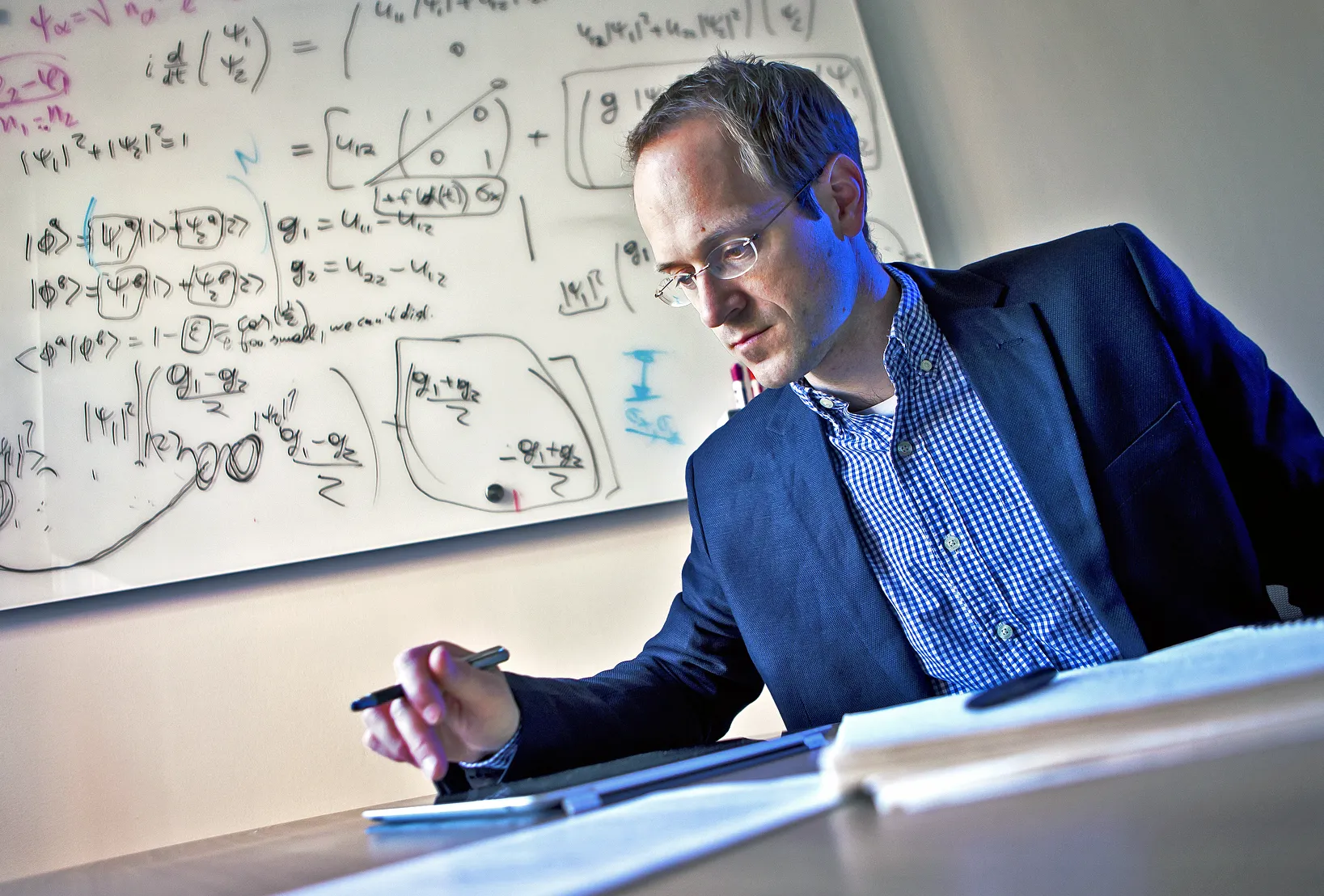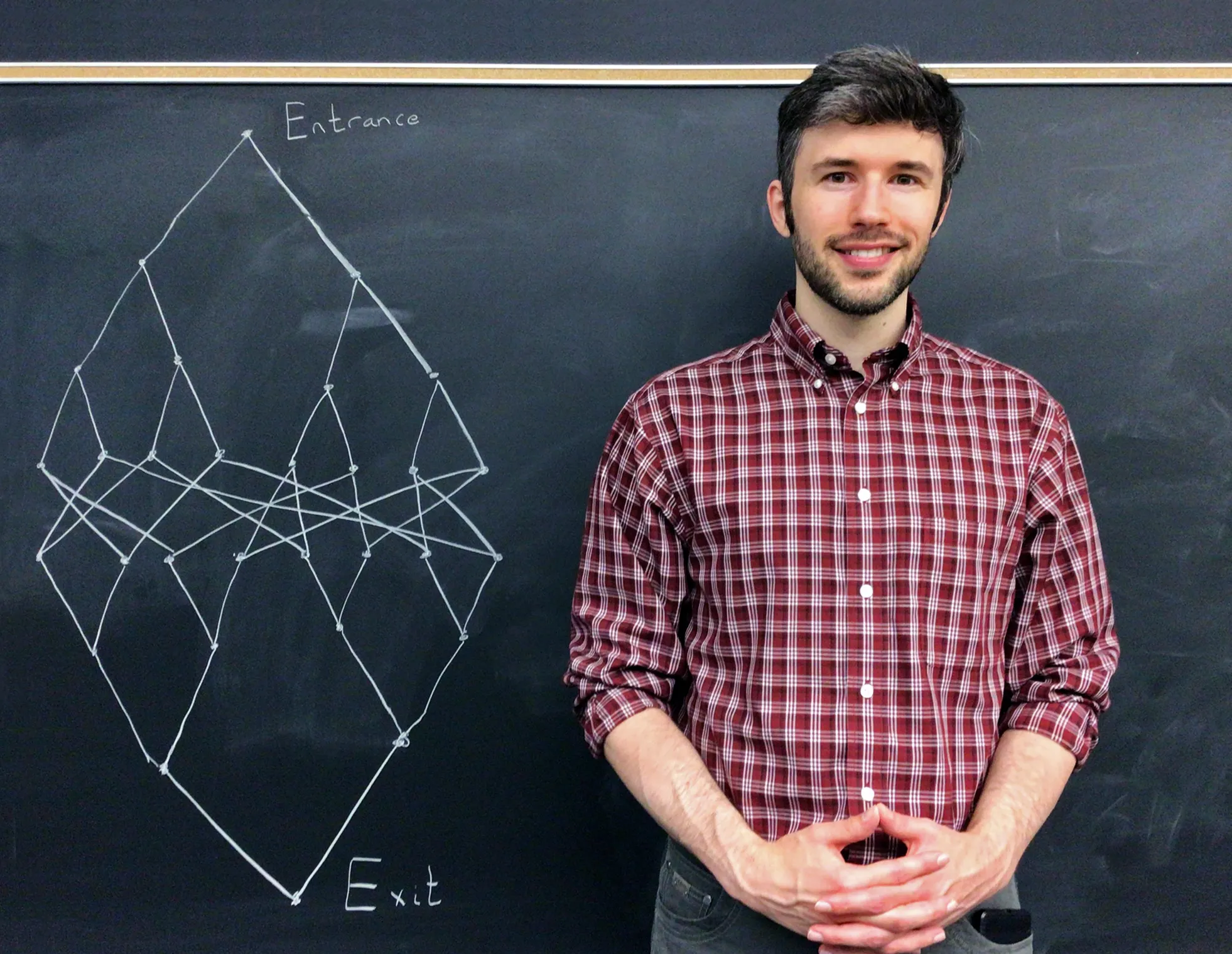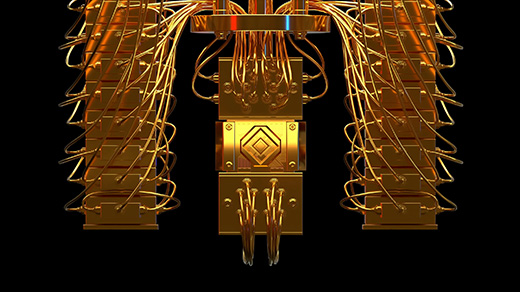To Move Fast, Quantum Maze Solvers Must Forget the Past

Tommy Parker for Quanta Magazine
Introduction
Imagine you visit a maze with some friends. You emerge from the exit shortly after going in, and wait around for hours before your friends emerge. Naturally, they ask about the path you took — surely you can retrace your steps and show them the way, right?
Not so in a world governed by the strange laws of quantum physics. Twenty years ago, quantum computing researchers developed an algorithm that harnessed those laws to traverse a specific kind of mathematical maze much faster than any algorithm running on an ordinary classical computer. But that speedup comes at a cost: The fast quantum algorithm finds the exit but has no idea how it got there.
Researchers have long wondered whether this trade-off is inevitable. Is it really impossible to find the exit quickly without forgetting the way?
“It’s kind of mind-blowing that you would even need to ask this question,” said Matthew Coudron, a computer scientist at the National Institute of Standards and Technology in Gaithersburg, Maryland.
Last November, Coudron and two colleagues took a big step toward resolving that long-standing problem: They proved that no algorithm in a broad and natural class of fast quantum algorithms can find a path through that special maze, called a welded tree graph. The results show that any hypothetical path-finding algorithm that doesn’t blindly guess would have to temporarily lose track of the entrance to have any chance of succeeding. It seems that forgetting is inevitable.
“There is no way I would have guessed that they could actually prove that,” said Simon Apers, a quantum computing researcher with the National Center for Scientific Research at the Institute for Research in Foundations of Computer Science in Paris, adding that the result “is very useful in illustrating what quantum algorithms can and cannot do.”
The Quantum Boost
Quantum computers owe their power in part to a phenomenon known as superposition, which effectively allows them to simultaneously explore many options that a classical computer would need to consider individually. But it’s not as simple as performing multiple calculations at once to save time. Checking the result of a superposition of choices never reveals a superposition of outcomes — rather, you only ever obtain one of the possible outcomes, each of which has a different probability. Quantum algorithms rely on the fact that contributions to these probabilities can interfere with each other like waves on the surface of a pond, boosting the probability of getting the right answer while reducing the probability of every other outcome.

In 2002, Andrew Childs helped identify a problem that quantum algorithms could solve exponentially faster than classical ones: getting from one root of the welded tree graph to the other.
John T. Consoli/University of Maryland
Because the interference has to work out just right, not every computational task is amenable to a quantum speedup, and indeed researchers are still working out where quantum algorithms can help, decades after quantum computing was first proposed. But they’ve had some notable successes. In 1994, Peter Shor developed a quantum algorithm for factoring large numbers — a task whose apparent difficulty for classical computers underlies much of modern cryptography. Shor’s algorithm could rapidly factor numbers so large that all known classical algorithms would be practically useless.
In 1996, the computer scientist Lov Grover found a second potentially practical example: a quantum algorithm for a very generic search problem, one akin to finding a single item hidden inside one of many identical boxes.
“Classically, what you could do is just randomly try one and see if it’s good, and then try again and see if it’s good, and you keep on trying until you find a good element,” Apers said. This approach takes time proportional to the number of boxes. Multiply that number by 100, and the search will be 100 times slower.
With a quantum algorithm, you can do better. Grover proved that if you set up a superposition of all the boxes, you can exploit interference to practically guarantee that the algorithm will select the right box at the end. The whole process takes time proportional to the square root of the number of boxes: Increasing that number by a factor of 100 only increases the runtime by a factor of 10.

Grover’s algorithm was a remarkably simple illustration of the value of quantum superposition, but the speedup it achieved was relatively modest — tasks that were far beyond the reach of the best classical algorithms would also stump Grover’s algorithm. Shor’s factoring algorithm had offered a glimpse of a dramatic gulf between the capabilities of quantum and classical computers. Was there a variant of Grover’s search problem that was like factoring — practically intractable for classical computers yet easy for quantum computers?
In the late 1990s, researchers began exploring this question by reformulating it as a question about graphs — networks of points, or nodes, connected by lines, called edges. Any search problem can be framed in the language of graph theory, with one node representing the starting point, another node representing the destination, and edges representing the possible choices at each step along the way
Grover’s problem, for example, corresponds to searching a graph in which every node is connected to every other node (because you can open boxes in any order). Different classical algorithms for a given search problem amount to different strategies for exploring the corresponding graph one node at a time, while quantum algorithms can move along multiple edges in superposition.
Branching Out
In 2002, a team of computer scientists finally identified a classically intractable search problem that a quantum algorithm could solve easily. They started with a simple graph called a tree, in which each node sprouts two edges leading to two more nodes, which each split into two more branches, and so on. Starting from a single “root” node, a tree graph branches many times before ending in a final layer of nodes called “leaves.” The team imagined taking two identical trees and “welding” them together by positioning them with the leaves facing each other and then using a random process to connect each leaf on one tree to two leaves on the other. They then posed the following question: Starting at one root of the welded tree graph, can you find your way to the other?
The welded tree graph is like a maze, with the entrance and exit at the two roots. Merrill Sherman/Quanta Magazine
Without a bird’s-eye view of the graph, any classical algorithm that attempts to solve this search problem will get hopelessly lost after reaching the middle layers of the graph — all the edges look identical, and there’s no way to distinguish those that point forward from those leading backward. An algorithm might stumble upon the exit node accidentally, but the average time it spends wandering around grows exponentially with the number of layers in the tree.
The authors of the 2002 paper proved that a simple quantum algorithm — a “quantum walk” that spreads through the graph evenly by taking many paths in superposition — can find its way to the exit much faster. That’s because the symmetric layout of the welded tree graph leads to interference between paths that concentrates flow in the forward direction. The exit node is “like a focus point of the algorithm,” said Alexander Belov, a computer scientist at the University of Latvia.

There’s a good chance that this quantum walk algorithm converges on the exit in time that’s merely proportional to the number of layers. That makes it exponentially faster than any classical algorithm — a speedup comparable to that of Shor’s factoring algorithm. But the interference that causes the quantum speedup also wipes out all record of the paths the algorithm traverses on its way to the exit.
Researchers wondered if there was some way to get the best of both worlds — a fast algorithm that identifies a path from entrance to exit.
“If it’s just the basic quantum walk that somehow finds the exit, that’s not going to work,” said Andrew Childs, a computer scientist at the University of Maryland, College Park who co-authored the 2002 paper as a graduate student and worked with Coudron on the new result. “But maybe you could soup it up in some way.”
Souping It Up
Among the first to approach the problem was Ansis Rosmanis, a computer scientist now at the Nagoya University Graduate School of Mathematics. In a 2010 paper, Rosmanis developed a class of algorithms that he dubbed “quantum snake walks,” which supplement the standard quantum walk algorithm with a memory of where they’ve been.
As the standard quantum walk algorithm flows through the graph, its next step depends solely on where it is currently — how it got there doesn’t matter. In Rosmanis’ snake walks, by contrast, you need to know the past to predict the future. Specifically, the evolution of the snake walk is determined by “snakes,” strings of adjacent nodes that the walk has previously passed through. There are many varieties of snake walks, differing among other respects in how the length of those snakes changes over the course of the walk.
Rosmanis showed that quantum snake walks using superpositions of multiple snakes could still exhibit helpful interference, despite remembering their trajectories, and that some snake walks could in principle find a path to the exit. But he couldn’t find a specific snake walk algorithm that did so quickly, and he also couldn’t prove that such an algorithm didn’t exist. Snake walks, it seemed, were promising, but too slippery to pin down. Rosmanis’ work was the last word on the path-finding problem for nearly a decade.

Matthew Coudron and Childs showed that if there is a fast quantum algorithm that finds a path through the graph, it must first lose track of the entrance.
Alexandru Cojocaru
Then in 2019, Coudron encountered the welded tree graph in a different context: He and a colleague proved that all quantum walk algorithms that find the exit lack a property universal among algorithms that were known to yield exponential quantum speedups for other problems. The result wasn’t directly related to path-finding, but Coudron began to suspect that the mathematical techniques that allowed him to prove this sweeping statement about the properties of all welded tree graph algorithms might also help resolve the question of whether snake walks (or other algorithms) could find a path. After moving to Maryland later that year, he struck up a collaboration with Childs, hoping to settle that question decisively.
Childs, Coudron and their graduate student Amin Shiraz Gilani began by making two assumptions to constrain the scope of the problem. First, they decided to ignore outlandish algorithms that would try to teleport to random points in the graph in hopes of stumbling upon the exit. This strategy is like trying to beat a video game by rooting around for a glitch to exploit — technically possible, perhaps, but against the spirit of the problem. It’s also hard to imagine that such behavior could be helpful, since the odds of landing in the right spot become minuscule on large graphs. Ignoring algorithms that hop around randomly made it easier to analyze the algorithms that remained, which the authors dubbed “genuine” algorithms — these included Rosmanis’ snake walk algorithms and perhaps others that nobody had yet discovered.
The authors’ second, more substantive assumption was that a fast path-finding algorithm would remain “rooted” — that is, it would build up a path to the exit node without ever losing track of the entrance. Many snake walks are rooted, but it’s possible in principle that an unrooted snake walk could find a path to the exit — it would have to detach from the entrance node and then find both entrance and exit later on.
The three researchers proved that for every genuine rooted quantum algorithm, they could cook up a classical algorithm that would mimic its observable behavior. Since they could also prove that no classical algorithm could find the exit quickly, that was enough to rule out this broad class of possible quantum path-finding algorithms. Genuine rooted algorithms simply can’t muster enough interference to find a path through the maze.
The Path Forward
The new result isn’t necessarily the end of the story. “Even after studying quantum algorithms for quite some time, they continue to surprise me,” Shelby Kimmel, a computer scientist at Middlebury College, wrote in an email. There may still be an ingenious path-finding algorithm outside the class the researchers considered, just waiting to be discovered.
While algorithms that aren’t genuine seem exceedingly unlikely to work, an unrooted algorithm could perhaps build up a path from entrance to exit by starting from somewhere in the middle. “Maybe you can set it up in such a way that the snake goes in and becomes unrooted, but then somehow decides to stretch out,” Childs said. “That is still not ruled out.”
Researchers have yet to find practical applications for the exponential quantum speedup that Childs and his colleagues discovered 20 years ago, in part because it depends on the special symmetry of the welded tree graph, which is unlikely to exist in any real-world network. But often there’s as much value in understanding what quantum algorithms can’t do. Shor’s discovery of a fast quantum algorithm for factoring large numbers, which threatens to undermine state-of-the-art cryptography, underscored the need for problems that are known to be hard for quantum algorithms as well.
One kind of cryptography not vulnerable to Shor’s algorithm relies on the assumption that it’s hard to find paths between points on specific graphs. Evidence that path-finding through welded trees is truly hard for quantum algorithms may motivate researchers to develop new cryptographic protocols based on the welded tree graph, though they haven’t had any luck so far.
“Maybe that means the kind of structure that’s in this problem is just not suitable for encoding problems that we care about,” Childs said. “Or maybe you just have to see it in the right way.”






